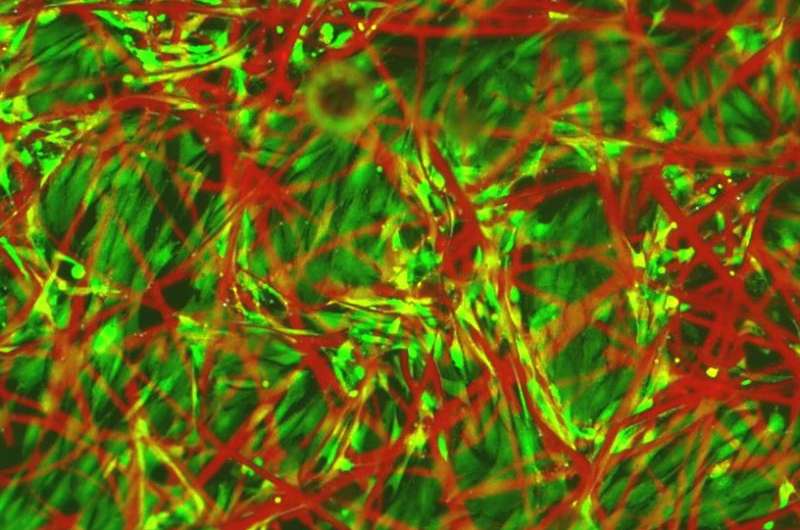Fluorescent material reveals how cells grow

Fibre from a semiconducting polymer, developed for solar cells, is an excellent support material for the growth of new human tissue. Researchers at Linköping University have shown that the fibre glows, which makes it possible to follow the growth of the cells inside living tissue.
The research findings, published in the reputable Advanced Functional Materials were reached in collaboration between researchers at Linköping University, Chalmers and Linköping University Hospital.
Being able to replace damaged organs and tissue with new tissue grown from cells from the recipient's own body is one of the goals of regenerative medicine. The research has come a long way; today, for example, people who have suffered serious burns can have their body's own skin grown. It is also known that cells grow better if they have some kind of support material, and several such materials have been tested.
Daniel Aili, senior lecturer at the Division of Molecular Physics at LiU, and doctoral student Abeni Wickham, together with their research colleagues, have now succeeded in developing a support material with very special properties:
"The material, a semiconducting polymer called TQ1, was initially developed for organic solar cells. But we have managed to process it to be a micro-fibrous material, like a mat of fibres where we can both study and stimulate the growth of tissue," says Dr Aili.
The material has a number of crucial benefits:
"What's interesting about it is that the cells seem to like the material and that it integrates well into living tissue. On top of that the fibres are fluorescent and glow in a wavelength range where we can see and follow the implant in the tissue. Until now, there has been a problem with soft biomaterials in that we have not been able to see how they integrate with living cells and tissue, and what happens with the material over time."
The researchers have also placed implants of spun TQ1 fibre in rats to be able to investigate the long-term effects. There have been no inflammations or other negative effects and the material has even shown that it can stimulate the growth of blood vessels in the tissue, which is a condition for the newly cultivated tissue to be able to be oxygenated and survive. The fluorescent properties of the material make it possible to follow its interaction with the tissue for as long as 90 days.
Animal experiments are strictly regulated and the research has passed reviews both for ethics and for animal rights.
The findings are a collaboration between six researchers from three divisions within the Department of Physics, Chemistry, and Biology at LiU; researchers from the Department of Clinical and Experimental Medicine at LiU; researchers at the Region Östergötland University Hospital; and one Chalmers researcher; Daniel Aili is the lead author.
More information: "Near-Infrared Emitting and Pro-Angiogenic Electrospun Conjugated Polymer Scaffold for Optical Biomaterial Tracking," Abeni Wickham et al, Advanced Functional Materials 2015. DOI: 10.1002/adfm.201500351



















